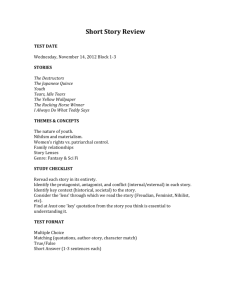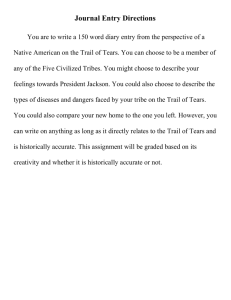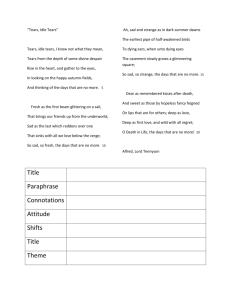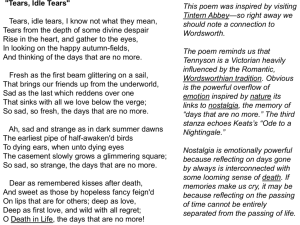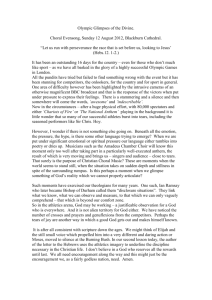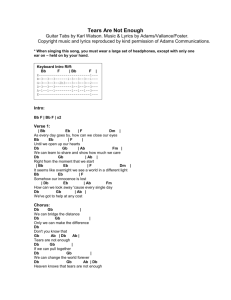The Outsiders: Connected Reading and Writing 7
advertisement
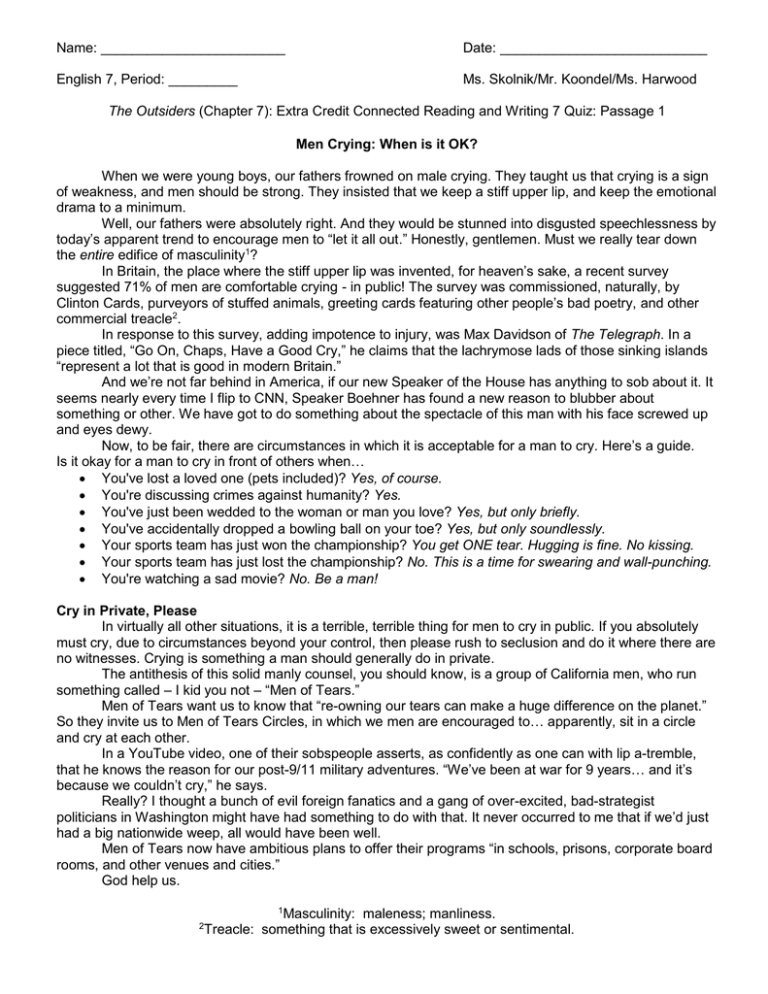
Name: ________________________ Date: ___________________________ English 7, Period: _________ Ms. Skolnik/Mr. Koondel/Ms. Harwood The Outsiders (Chapter 7): Extra Credit Connected Reading and Writing 7 Quiz: Passage 1 Men Crying: When is it OK? When we were young boys, our fathers frowned on male crying. They taught us that crying is a sign of weakness, and men should be strong. They insisted that we keep a stiff upper lip, and keep the emotional drama to a minimum. Well, our fathers were absolutely right. And they would be stunned into disgusted speechlessness by today’s apparent trend to encourage men to “let it all out.” Honestly, gentlemen. Must we really tear down the entire edifice of masculinity1? In Britain, the place where the stiff upper lip was invented, for heaven’s sake, a recent survey suggested 71% of men are comfortable crying - in public! The survey was commissioned, naturally, by Clinton Cards, purveyors of stuffed animals, greeting cards featuring other people’s bad poetry, and other commercial treacle2. In response to this survey, adding impotence to injury, was Max Davidson of The Telegraph. In a piece titled, “Go On, Chaps, Have a Good Cry,” he claims that the lachrymose lads of those sinking islands “represent a lot that is good in modern Britain.” And we’re not far behind in America, if our new Speaker of the House has anything to sob about it. It seems nearly every time I flip to CNN, Speaker Boehner has found a new reason to blubber about something or other. We have got to do something about the spectacle of this man with his face screwed up and eyes dewy. Now, to be fair, there are circumstances in which it is acceptable for a man to cry. Here’s a guide. Is it okay for a man to cry in front of others when… You've lost a loved one (pets included)? Yes, of course. You're discussing crimes against humanity? Yes. You've just been wedded to the woman or man you love? Yes, but only briefly. You've accidentally dropped a bowling ball on your toe? Yes, but only soundlessly. Your sports team has just won the championship? You get ONE tear. Hugging is fine. No kissing. Your sports team has just lost the championship? No. This is a time for swearing and wall-punching. You're watching a sad movie? No. Be a man! Cry in Private, Please In virtually all other situations, it is a terrible, terrible thing for men to cry in public. If you absolutely must cry, due to circumstances beyond your control, then please rush to seclusion and do it where there are no witnesses. Crying is something a man should generally do in private. The antithesis of this solid manly counsel, you should know, is a group of California men, who run something called – I kid you not – “Men of Tears.” Men of Tears want us to know that “re-owning our tears can make a huge difference on the planet.” So they invite us to Men of Tears Circles, in which we men are encouraged to… apparently, sit in a circle and cry at each other. In a YouTube video, one of their sobspeople asserts, as confidently as one can with lip a-tremble, that he knows the reason for our post-9/11 military adventures. “We’ve been at war for 9 years… and it’s because we couldn’t cry,” he says. Really? I thought a bunch of evil foreign fanatics and a gang of over-excited, bad-strategist politicians in Washington might have had something to do with that. It never occurred to me that if we’d just had a big nationwide weep, all would have been well. Men of Tears now have ambitious plans to offer their programs “in schools, prisons, corporate board rooms, and other venues and cities.” God help us. 1 Masculinity: maleness; manliness. Treacle: something that is excessively sweet or sentimental. 2 Name: ________________________ Date: ___________________________ English 7, Period: _________ Ms. Skolnik/Mr. Koondel/Ms. Harwood The Outsiders (Chapter 7): Extra Credit Connected Reading and Writing 7 Quiz: Passage 2 The Health Benefits of Tears By Judith Orloff, M.D. For over twenty years as physician, I’ve witnessed, time and again, the healing power of tears. Tears are your body’s release valve for stress, sadness, grief, anxiety, and frustration. Also, you can have tears of joy, say when a child is born or tears of relief when a difficulty has passed. In my own life, I am grateful when I can cry. It feels cleansing, a way to purge pent up emotions so they don’t lodge in my body as stress symptoms such as fatigue or pain. To stay healthy and release stress, I encourage my patients to cry. For both men and women, tears are a sign of courage, strength, and authenticity. In my new book I discuss the numerous health benefits of tears. Like the ocean, tears are salt water. Protectively they lubricate your eyes, remove irritants, reduce stress hormones, and they contain antibodies that fight pathogenic microbes. Our bodies produce three kinds of tears: reflex, continuous, and emotional. Each kind has different healing roles. For instance, reflex tears allow your eyes to clear out noxious particles when they’re irritated by smoke or exhaust. The second kind, continuous tears, are produced regularly to keep our eyes lubricated--these contain a chemical called “lysozyme” which functions as an anti-bacterial and protects our eyes from infection. Tears also travel to the nose through the tear duct to keep the nose moist and bacteria free. Typically, after crying, our breathing, and heart rate decrease, and we enter into a calmer biological and emotional state. Emotional tears have special health benefits. Biochemist and “tear expert” Dr. William Frey at the Ramsey Medical Center in Minneapolis discovered that reflex tears are 98% water, whereas emotional tears also contain stress hormones which get excreted from the body through crying. After studying the composition of tears, Dr. Frey found that emotional tears shed these hormones and other toxins which accumulate during stress. Additional studies also suggest that crying stimulates the production of endorphins, our body’s natural pain killer and “feel-good” hormones.” Interestingly, humans are the only creatures known to shed emotional tears, though it’s possible that that elephants and gorillas do too. Other mammals and also salt-water crocodiles produce reflex tears which are protective and lubricating. Crying makes us feel better, even when a problem persists. In addition to physical detoxification, emotional tears heal the heart. You don’t want to hold tears back. Patients sometimes say, “Please excuse me for crying. I was trying hard not to. It makes me feel weak.” My heart goes out to them when I hear this. I know where that sentiment comes from: parents who were uncomfortable around tears, a society that tells us we’re weak for crying--in particular that “powerful men don’t cry.” I reject these notions. The new enlightened paradigm of what constitutes a powerful man and woman is someone who has the strength and self awareness to cry. These are the people who impress me, not those who put up some macho front of faux-bravado. Try to let go of outmoded, untrue, conceptions about crying. It is good to cry. It is healthy to cry. This helps to emotionally clear sadness and stress. Crying is also essential to resolve grief, when waves of tears periodically come over us after we experience a loss. Tears help us process the loss so we can keep living with open hearts. Otherwise, we are a set up for depression if we suppress these potent feelings. When a friend apologized for curling up in the fetal position on my floor, weeping, depressed over a failing romance, I told her, “Your tears blessed my floor. There is nothing to apologize for.” I’ve been this enthusiastic about crying for years. In fact, during my psychiatric residency at UCLA when supervisors and I watched videos of me with patients, they’d point out that I’d smile when a patient cried. “That’s inappropriate,” they’d say. I disagreed then; still do. I wasn’t smiling because my patients were depressed or grieving. I was smiling because they were courageously healing depression or other difficult emotions with tears. I was happy for their breakthrough. In my life, too, I love to cry. I cry whenever I can. Wish I could more. Thank God our bodies have this capacity. I hope you too can appreciate the experience. Let your tears flow to purify stress and negativity. Name: ________________________ Date: ___________________________ English 7, Period: _________ Ms. Skolnik/Mr. Koondel/Ms. Harwood The Outsiders (Chapter 7): Extra Credit Connected Reading and Writing 7 Quiz Directions: clearly write the correct letter in the space provided. PASSAGE 1 _____1. In Passage 1, the author states, “Honestly, gentlemen. Must we really tear down the entire edifice of masculinity?” The author’s main idea is A. Masculine men are incapable of crying. B. Masculinity and strength are important values that are weakened when men cry publicly. C. Women are more emotional than men, so it is appropriate for them to cry publicly. D. In modern society, men have lost the capacity to be masculine. _____2. In Passage 1, the author most likely cites the Clinton Cards’ survey suggesting that 71% of men are comfortable crying in public because A. The survey supports the author’s claim that men’s masculinity is being eroded. B. The author is intolerant of all public displays of emotion. C. The survey suggests that the majority of men who cry in public demonstrate courage. D. The survey provides clear evidence that there are still some men who do not cry in public. _____3. In Passage 1, when describing the California group called “Men of Tears,” the author’s tone could best be described as all of the following EXCEPT A. sarcastic B. dismissive C. considerate D. mocking PASSAGE 2 _____4. In Passage 2, the author’s second paragraph mostly highlights which positive effect of crying? A. healing and health benefits B. emotional and psychiatric benefits C. evolutional and historical benefits D. social and societal benefits _____5. In Passage 2, the author supports her claim that crying is beneficial to people’s emotional and physical health by providing all of the following facts EXCEPT A. Emotional tears shed hormones and other toxins which accumulate during stress. B. Crying stimulates the production of endorphins. C. Humans are the only creatures known to shed emotional tears. D. Crying makes us feel better, even when a problem persists. _____6. In Passage 2, the author would most likely characterize the opinions expressed in Passage 1 as all of the following EXCEPT A. lacking courage B. outmoded and untrue C. falsely macho and manly D. enlightened and self-aware Extra Credit Short Response: If you were Ponyboy’s friend, would you encourage him to cry or “keep a stiff upper lip” when he learns about the severity of Johnny’s condition? Use details from both articles to explain why you agree with one and disagree with the other. ___________________________________________________________________ ___________________________________________________________ ___________________________________________________________ ___________________________________________________________ ___________________________________________________________ ___________________________________________________________ ___________________________________________________________ ___________________________________________________________ ___________________________________________________________ ___________________________________________________________ ___________________________________________________________ ___________________________________________________________ ___________________________________________________________ ___________________________________________________________ ___________________________________________________________ ___________________________________________________________ ___________________________________________________________ ___________________________________________________________ ___________________________________________________________ ___________________________________________________________ ___________________________________________________________ Score Points 2 Point 1 Point 0 Point Total Score Short Response Rubric (10 Points Total) Response Features Addresses all of the requirements of the prompt Valid inferences and/or claims from the text Evidence of analysis of the text Relevant and sufficient facts, definitions, concrete details, and/or other information from the text Complete sentences where errors do not impact readability Addresses some of the requirements of the prompt A mostly literal recounting of events or details Some evidence of analysis of the text Some relevant facts, definitions, concrete details, and/or other information from the text to develop response Some incomplete sentences and errors in spelling/grammar/syntax where errors impact readability Does not address any requirements of the prompt No inferences and/or claims from the text No evidence of analysis of the text No relevant facts, definitions, concrete details, and/or other information from the text to develop response Many incomplete sentences and errors in spelling/grammar/syntax where errors significantly interfere with readability Extra Credit Extended Response: What is the main idea of “Men Crying: When is it OK?” What is the main idea of “The Health Benefits of Tears,” by Judith Orloff, M.D.? In your answer, be sure to o Describe the main idea of “Men Crying: When is it OK?” o Describe the main idea of “The Health Benefits of Tears,” by Judith Orloff, M.D. o Use details from both articles to support your answer ___________________________________________________________ ___________________________________________________________________ ___________________________________________________________________ ___________________________________________________________________ ___________________________________________________________________ ___________________________________________________________________ ___________________________________________________________________ ___________________________________________________________________ ___________________________________________________________________ ___________________________________________________________________ ___________________________________________________________________ ___________________________________________________________________ ___________________________________________________________________ ___________________________________________________________________ ___________________________________________________________________ ___________________________________________________________________ ___________________________________________________________________ ___________________________________________________________________ ___________________________________________________________________ ___________________________________________________________________ ___________________________________________________________________ ___________________________________________________________________ ___________________________________________________________________ ___________________________________________________________________ ___________________________________________________________________ ___________________________________________________________________ ___________________________________________________________________ ___________________________________________________________________ ___________________________________________________________________ ___________________________________________________________________ ___________________________________________________________________ ___________________________________________________________________ ___________________________________________________________________ ___________________________________________________________________ ___________________________________________________________________ ___________________________________________________________________ ___________________________________________________________________ ___________________________________________________________________ ___________________________________________________________________ ___________________________________________________________________ ___________________________________________________________________ ___________________________________________________________________ ___________________________________________________________________ ___________________________________________________________________ ___________________________________________________________________ ___________________________________________________________________ ___________________________________________________________________ ___________________________________________________________________ ___________________________________________________________________ ___________________________________________________________________ ___________________________________________________________________ Extended Response Rubric (28 Points Total) If the prompt requires two texts and the student only references one text, the response can be scored no higher than a 2. Score Points Response Features Clearly introduces topic compellingly and follows logically from the task Demonstrates insightful analysis of the text(s) 4 Point Develops the topic with relevant, well-chosen facts, definitions, details, quotations, or other information or examples from the text(s) Exhibits clear organization with appropriate and varied transitions to create a unified whole and enhance meaning Maintains a formal style, using sophisticated language and notable voice Provides a logical concluding statement or section that is compelling Demonstrates command of conventions with few errors Clearly introduces topic and follows logically from the task Demonstrates grade-appropriate analysis of the text(s) 3 Point Develops the topic with relevant facts, definitions, details, quotations, or other information or examples from the text(s) Exhibits clear organization with appropriate transitions Maintains a formal style, using precise language Provides a logical concluding statement or section that follows from the topic Demonstrates grade-level command of conventions with occasional errors Introduces topic and follows generally from the task Demonstrates a literal comprehension of the text(s) Partially develops the topic with some relevant textual evidence 2 Point Exhibits some attempt at organization with inconsistent use of transitions Fails to maintain a formal style, with inconsistent use of language/vocabulary Provides a concluding statement/ section that follows generally from the topic Demonstrates grade-level command of conventions with occasional errors Introduces topic in a manner that does not logically follow from the task Demonstrates little understanding of the text(s) Demonstrates an attempt to use evidence; develops ideas 1 Point minimally/irrelevantly Exhibits little attempt at organization and may be irrelevant to task Lacks a formal style, with imprecise/inappropriate use of language/vocabulary Provides a concluding statement/section that is illogical or unrelated to topic Demonstrates a lack of command of conventions with frequent errors Demonstrates a lack of comprehension of the task Demonstrates a lack of comprehension of the text(s) Provides no evidence or irrelevant evidence 0 Point No evidence of organization Uses language that is incoherent or simply copied from the text Does not provide a concluding statement/section Demonstrates no command of conventions Total Score
